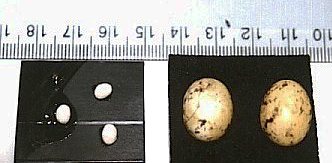Achatininae
Achatina
Strophocheilidae
Other Species
Slugs
Achatina/Archachatina Identification
The first thing for you to do is to identify what group (genus) a snail belongs to. Currently there seem to be four fairly reliable methods.
Shell Shape
Achatina snails have a pointed apex and Archachatina snails have a much blunter one. Until you have owned an Archachatina and you can compare the two together it can be hard to tell which yours is.
To help with this I have drawn a guide to what the very last whorl will look like:
Achatina

Archachatina

Achatina

Archachatina

Tail "V" Shape
As far as we know, all Archachatina snails have a V shape on their tail. So far, we only know of one Achatina which has this. It is called Achatina achatina which luckily is one of the easiest Achatina to identify for a number of reasons.
The V is a raised, serrated bump. It is easy to feel if you wet your finger and run it over the tail.
Sometimes Achatina snails seem to show a lighter V shape on their tail. This is just a change in colour and it is not raised. If it looks like a V but doesn't have a distinctive V ridge then it is an Achatina.
Achatina

Archachatina

Achatina

Archachatina

Size of Skin texture
There is a name for this but it escapes me. Let us call them pores. Archachatina have much smaller and tighter knit pores.
Examples of Achatina skin



Examples of Archachatina skin



Egg Size
Achatina snails lay small eggs 4-10 mm in diameter, in batches of 20 - 400.
Archachatina snails lay larger eggs 12-20 mm in diameter, in batches of 6 - 20.
One particular type of snail, Achatina iredalei doesn't lay eggs. It is actually ovo-viviparous and gives birth to live young. The eggs are stored and incubated internally.



































